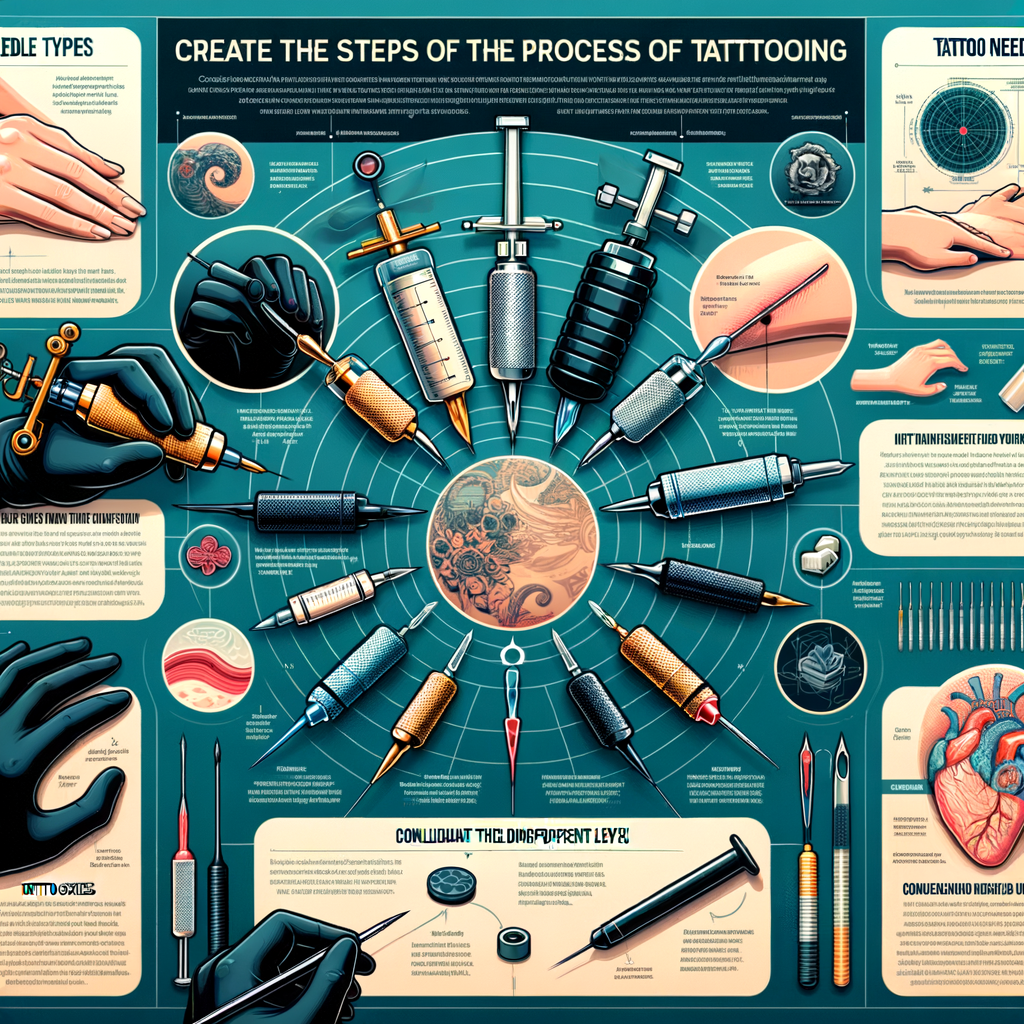
Introduction: The Tattoo Process and Tattoo Needles Depth
Getting a tattoo is a unique experience that involves a specific process and tools. One of the main tools used in tattooing is the tattoo needle. Understanding how these needles work, including how deep they penetrate the skin, can help you feel more comfortable and informed about the tattooing process.
-
- Understanding the tattoo process
Tattooing is an art form that has been practiced for centuries. It involves injecting ink into the second layer of your skin, known as the dermis. This process starts with the tattoo artist drawing your chosen design on your skin with a stencil. Then, they use a tattoo machine, which has a group of needles attached to it. These needles dip into the tattoo ink and then puncture your skin at a rapid speed. This introduces the ink into your dermis, creating the tattoo.
-
- How deep do tattoo needles go?
Tattoo needles penetrate your skin to a depth of approximately 1 to 2 millimeters. This is just enough to reach the dermis without going too deep. If the needle goes too shallow, the tattoo won’t last. If it goes too deep, it can cause unnecessary pain and bleeding. Therefore, the skill of the tattoo artist is crucial in ensuring the needle goes just the right depth.
In the following sections, we will delve deeper into the types of tattoo needles, their uses, and sizes. We will also debunk some common myths about tattooing, discuss the pain level you can expect during the process, and provide essential safety information about tattoo needles. Whether you’re considering getting your first tattoo or simply want to understand the process better, this guide will provide you with the information you need.
Tattoo Needle Types and Their Uses
Understanding the different types of tattoo needles and their uses is crucial for anyone considering getting a tattoo. Each needle type serves a unique purpose and creates a different effect on the skin. Let’s explore the four main types of tattoo needles: Round Liners, Round Shaders, Magnum Shaders, and Flat Shaders.
-
- Round Liners
Round Liners are commonly used for creating fine lines and detailed work. They are grouped together in a round pattern, hence the name. These needles are perfect for outlining and defining the tattoo design. They provide precision and are often used for intricate tattoos that require a high level of detail.
-
- Round Shaders
Round Shaders, on the other hand, are used for shading and coloring in tattoo designs. They are arranged in a circular pattern like Round Liners but are designed to cover larger areas. Round Shaders are great for adding depth and dimension to a tattoo, making it look more realistic.
-
- Magnum Shaders
Magnum Shaders are used for filling in large areas with color or for shading. They have a double row of needles that are spread out more than Round Shaders, allowing for a softer and more diffused line. This makes Magnum Shaders ideal for creating gradient effects or shading large areas quickly.
-
- Flat Shaders
Flat Shaders are used for geometric designs and areas that require a solid color. These needles are lined up in a straight row, creating a flat line. They are excellent for bold, straight lines and are commonly used in tribal or geometric tattoos.
Each type of needle has its unique benefits and uses. The choice of needle depends on the tattoo design, the desired effect, and the tattoo artist’s preference. Understanding these needle types can help you make an informed decision about your tattoo and ensure you get the best possible result.
Tattoo Needle Guide: Sizes and Their Applications
When it comes to tattooing, the size of the needle plays a crucial role in the outcome of the design. Different needle sizes are used for different applications, and understanding these can help you achieve the best results. In this section, we will delve into the world of tattoo needle sizes and their applications.
- Understanding Tattoo Needle Sizes
Tattoo needles come in a variety of sizes, each designed for a specific purpose. The size of a tattoo needle is determined by two factors: the diameter of the needle, often referred to as the # (number) and the configuration of the needle.
The # indicates the diameter of the needle. For instance, a #12 needle, which is a standard size, has a 0.35mm diameter. On the other hand, a #10 needle is thinner with a 0.30mm diameter, and a #8 needle is even thinner at 0.25mm.
The configuration of the needle refers to how the needles are grouped together. For example, RL or Round Liner needles are grouped in a round formation, ideal for line work. RS or Round Shader needles are also grouped in a round formation but are used for shading.
Here’s a simple table to help you understand:
| Needle Size | Diameter | Common Use |
|---|---|---|
| #12 | 0.35mm | Line work and shading |
| #10 | 0.30mm | Finer line work and shading |
| #8 | 0.25mm | Detail work |
- Choosing the Right Needle Size for Your Tattoo
Choosing the right needle size for your tattoo is essential for achieving the desired result. The size you choose will depend on the type of tattoo you’re getting and the level of detail it requires.
For instance, if you’re getting a tattoo with a lot of fine lines and intricate details, a smaller needle like a #8 might be the best choice. On the other hand, if you’re getting a larger tattoo with bold lines and shading, a larger needle like a #12 might be more suitable.
Remember, the right needle size can make a significant difference in the quality of your tattoo. It’s always best to consult with a professional tattoo artist who can guide you in making the right choice.
In conclusion, understanding tattoo needle sizes and their applications is a crucial part of the tattoo process. By choosing the right needle size, you can ensure the best possible outcome for your tattoo.
Tattooing Techniques and Tattoo Needle Penetration
When it comes to tattooing, the technique used plays a crucial role in the final outcome. The depth of needle penetration also significantly influences the tattoo’s appearance and longevity. Let’s delve into some traditional tattooing techniques.
Traditional Tattooing Techniques
Traditional tattooing techniques have been passed down through generations and are still widely used today. These techniques primarily include outlining, shading, and coloring.
-
- Outlining
Outlining, also known as line work, is the first step in the tattooing process. It involves creating a basic structure for the design. The tattoo artist uses a group of needles tied together in a tight round configuration to create crisp, clean lines. The needle penetrates the skin to a depth of about 1mm, depositing the ink into the dermis, the second layer of the skin.
-
- Shading
Shading is the technique used to add depth and dimension to the tattoo. It involves varying the density of the ink and the distance between the needle points to create a gradient effect. The needle penetration for shading is slightly less than that for outlining, as the aim is to create a softer, more subtle effect.
-
- Coloring
Coloring is the final step in the tattooing process. It involves filling in the outlined design with color. The tattoo artist uses a magnum needle, which is a group of needles arranged in two rows, to cover larger areas more efficiently. The needle penetration for coloring is similar to that for shading.
Understanding these techniques can help you appreciate the skill and craftsmanship that goes into every tattoo. It’s also important to remember that the depth of needle penetration can affect the tattoo’s appearance and longevity, so it’s crucial to choose a skilled and experienced tattoo artist.
Modern Tattooing Techniques
As the art of tattooing continues to evolve, artists are constantly developing new techniques to create unique and stunning designs. Let’s explore some of the modern tattooing techniques that are popular today.
-
- Realism
Realism, as the name suggests, is a technique that aims to create tattoos that are as realistic as possible. This technique requires a high level of skill and precision, as the artist must capture the smallest details to create a lifelike image. Realism tattoos can include portraits, animals, landscapes, and more. The key to a successful realism tattoo is the artist’s ability to create depth and dimension, making the tattoo appear almost three-dimensional.
-
- Watercolor
Watercolor tattoos are a relatively new technique that mimics the look of a watercolor painting. These tattoos are characterized by their vibrant colors and lack of black outlines. Instead, the colors blend together, creating a soft and fluid appearance. Watercolor tattoos can be of any subject matter, but they are particularly effective for floral and nature-inspired designs. While beautiful, these tattoos may require more frequent touch-ups to maintain their vibrant colors.
-
- Geometric
Geometric tattoos are a modern technique that uses shapes and patterns to create a design. These tattoos often incorporate elements of sacred geometry, which assigns symbolic and sacred meanings to certain geometric shapes. Geometric tattoos can be simple or complex, and they can be standalone designs or incorporated into other styles. The precision required for geometric tattoos makes them a challenging but rewarding technique for many tattoo artists.
In conclusion, modern tattooing techniques offer a wide range of possibilities for both artists and clients. Whether you’re drawn to the lifelike detail of realism, the vibrant colors of watercolor, or the intricate patterns of geometric designs, there’s a modern tattooing technique that’s perfect for you.
Debunking the Myth: Do Tattoo Needles Really Touch Bone?
There’s a common myth that tattoo needles penetrate so deep they touch the bone. This is, in fact, a misconception. Let’s debunk this myth and understand the depth of tattoo needle penetration and the tattooing process.
-
- How deep do tattoo needles actually go?
Tattoo needles penetrate your skin to a depth of approximately 1/16 of an inch, or about the thickness of three pennies stacked together. This is just deep enough to bypass the outer layer of your skin, the epidermis, and inject ink into the second layer, the dermis. The dermis layer is more stable than the epidermis, which is why tattoos are permanent. It’s important to note that the depth can vary slightly based on the technique used by the tattoo artist and the type of needle, but it’s nowhere near deep enough to reach the bone.
-
- What does the tattooing process feel like?
The sensation of getting a tattoo is often described as a continuous scratch or a series of pricks. Some people also liken it to the feeling of a cat scratch or a sunburn. The level of discomfort can vary based on your pain tolerance, the location of the tattoo, and the skill of the tattoo artist. It’s important to remember that everyone’s experience is different, and what might be painful for one person might be a breeze for another.
In conclusion, the myth that tattoo needles touch the bone is just that – a myth. The tattooing process is designed to be safe and relatively comfortable, with needles penetrating only as deep as necessary to create a lasting image. So, if you’re considering getting a tattoo, don’t let this myth deter you. Armed with the right information, you can make an informed decision about whether or not a tattoo is right for you.
Tattoo Pain Level: What to Expect
Getting a tattoo involves a certain level of discomfort. However, the pain varies from person to person and is influenced by several factors. In this section, we will discuss what affects the pain level and how you can manage it.
- Factors affecting tattoo pain level
Several factors can influence the level of pain you experience during a tattoo session. These include:
- Placement: Some areas of the body are more sensitive than others. For instance, tattoos on the ribs, feet, or hands tend to be more painful.
- Size and complexity: Larger, more complex designs often require longer sessions, which can increase the level of discomfort.
- Individual pain tolerance: Everyone’s pain threshold is different. What might be painful for one person may be bearable for another.
- Tattoo artist’s technique: The skill and technique of the tattoo artist can also affect the pain level. Experienced artists are often able to minimize discomfort.
- How to manage tattoo pain
While getting a tattoo can be uncomfortable, there are several strategies you can use to manage the pain:
- Stay hydrated: Drinking plenty of water before your session can help your skin take the ink better, potentially reducing discomfort.
- Get plenty of rest: Being well-rested can increase your pain tolerance.
- Use a numbing cream: Some tattoo shops offer numbing creams that can help reduce the pain. However, it’s important to discuss this with your artist beforehand.
- Breathe deeply: Deep, slow breathing can help you relax and manage the pain better.
Remember, everyone’s experience with tattoo pain is unique. What works for one person may not work for another. It’s important to communicate with your tattoo artist about any concerns or questions you may have.
Tattoo Needle Safety: What You Need to Know
When it comes to getting a tattoo, safety should be your top priority. This includes understanding the importance of using new, sterile needles and knowing what to look for in a tattoo studio. Let’s delve into these crucial aspects.
- Importance of using new, sterile needles
Using new, sterile needles for each tattoo is essential for your health and safety. Reusing needles can lead to the spread of diseases like Hepatitis B, Hepatitis C, and HIV. According to the Centers for Disease Control and Prevention, there have been cases where people contracted these diseases from tattoo parlors that reused needles.
Moreover, using a new needle ensures that the tattoo process is smooth and less painful. A dull, used needle can cause unnecessary pain and may not deliver the ink properly, affecting the quality of your tattoo.
- What to look for in a tattoo studio
Choosing the right tattoo studio is just as important as the design of your tattoo. Here are a few things to look for:
- Hygiene: The studio should be clean and well-maintained. The artists should use gloves, and the equipment should be sterilized.
- Professionalism: The artists should be professional, knowledgeable, and willing to answer your questions about the tattoo process.
- License: The studio should have a valid license. This ensures that they meet the health and safety standards set by the local health department.
- Portfolio: Check the artist’s portfolio to see their previous work. This can give you an idea of their style and quality.
Remember, getting a tattoo is a significant decision. It’s not just about the design, but also about the safety and hygiene practices followed by the studio. Make sure to do your research and choose a studio that prioritizes your health and safety.
Conclusion: Essential Tattoo Needle Information for First-Timers
As we wrap up our comprehensive guide on tattoo needles, it’s important to revisit the key takeaways and offer some final advice for those considering getting a tattoo. Remember, knowledge is power, and understanding the tattooing process can help you make informed decisions about your body art.
-
- Key takeaways about tattoo needles and the tattooing process:
Tattoo needles come in various types and sizes, each serving a specific purpose. The needle type and size used can significantly impact the tattoo’s appearance and the level of discomfort experienced during the process. It’s also crucial to note that tattoo needles do not touch the bone; they only penetrate the skin’s dermal layer. Safety is paramount in the tattooing process, and professional tattoo artists adhere to strict hygiene and sterilization protocols to ensure a safe and clean environment.
-
- Final advice for those considering getting a tattoo:
If you’re considering getting a tattoo, it’s essential to do your research and choose a reputable tattoo artist. Don’t hesitate to ask questions about the tattooing process, including the type and size of the needle to be used. Remember, getting a tattoo is a significant decision, and you should feel comfortable and confident in your choice. Lastly, always follow the aftercare instructions provided by your tattoo artist to ensure your tattoo heals properly and maintains its vibrant colors.
In conclusion, understanding the role of tattoo needles in the tattooing process can enhance your overall tattoo experience. Armed with this information, you can confidently embark on your tattoo journey. Remember, every tattoo is a unique expression of self, and the journey should be just as meaningful as the artwork itself.






